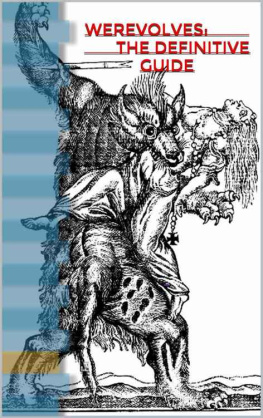PLATE I

THE WARLOCKERS METAMORPHOSIS
By Goya
THE WEREWOLF
IN LORE AND LEGEND
MONTAGUE SUMMERS
Intrabunt lupi rapaces in uos, non parcentes gregi.
ACTUS APOSTOLORUM, XX, 29.
DOVER PUBLICATIONS, INC.
MINEOLA NEW YORK
Bibliographical Note
The Werewolf in Lore and Legend, first published in 2003, is an unabridged republication of the work originally published in 1933 by Kegan Paul, Trench, Trubner & Co., Ltd., London, under the title The Werewolf.
Library of Congress Cataloging-in-Publication Data
Summers, Montague, 1880-1948.
[Werewolf]
The werewolf in lore and legend / Montague Summers.
p. cm.
Originally published: The werewolf. London : K. Paul, Trench, Trubner, 1933.
Includes bibliographical references and index.
ISBN 0-486-43090-1 (pbk.)
1. Werewolves. I. Title.
GR830.W4S8 2003
398'.45dc22
2003063519
Manufactured in the United States of America
Dover Publications, Inc., 31 East 2nd Street, Mineola, N.Y. 11501
LIST OF ILLUSTRATIONS
INTRODUCTION
S OME three or four years ago when this present book, The Werewolf, which had long been planned, definitely began to take shape as a successor to my study, The Vampire, it was my original intention to include in the survey the were-tiger and the were-jaguar, the were-lion and were-leopards, the Abyssinian were-hyena, the were-fox and werewolves of China, and many more. I soon realized, however, that owing to the abundance of data it would prove quite impossible in one volume to travel outside Europe, that is to say, if the subject was to be treated in anything like adequate fashion. This led to a slight re-casting, and in some details a curtailment, of the first two chapters.
Owing to various circumstances I was unable to complete this book either as early or as speedily as I hoped, and during the delay, slight though it actually proved, I found notes and references had continued to grow and accumulate in such profusion that it was not merely a question of excluding four continents, but there had now arisen the necessity of making a very limited and by no means easy selection from the material entirely relevant and proper to the inquiry which I was pursuing, and yet difficult to comprise within the boundaries and bournes I had already somewhat rigidly set myself and to whose rules I straitly determined to confine my ambit.
In consequence I cannot but be very well aware that my chapter on France, my final chapter, and my note on the Werewolf in Literature might be and without much labour considerably extended, nor has the temptation to do this often been absent. Indeed, I have constantly been obliged to remind myself pretty sharply succincti quae sint bona libelli.
Werewolfery is of itself a vast subject, and when we quite legitimately extend our pervestigation to shape-shifting and animal-metamorphosis in general the field is immense. It would have been only too simple a matter, if I had desired, to farse and bombast my notes with scores upon scores of further references, no mean quota of which might fairly have been argued to be, if unessential, at least not impertinent, but although such a shop-window display will impress the silly crowd, it is justly valued at its true worth by the scholar.  , quoth Hesiod of old.
, quoth Hesiod of old.
Although lycanthropy has incidentally been treated and more or less briefly referred to by many authors, the number of treatises which concentrate upon this important and world-ancient theme is actually very small. Towards the end of the sixteenth century and at the beginning of the seventeenth there may be distinguished four valuable studies, written it is to be noted from different points of view but all directly inspired by Jean Bodins famous chapter, ii, 6, in the Dmonomanie des Sorciers, 1580, which has rubric: De la Lycanthropie & si les esprits peuuent changer les hommes en bestes.
The first, and by far the best, of our mournival is the work of the learned Wolfeshusius, De Lycanthropia Pro sententia loan. Bodini Iurecos. Galli aduersus dissentaneas aliquorum opiniones nouiter assertum, published at Leipzig, 8vo, 1591. Five years later, in 1596, the Franciscan Claude Prieur published his Dialogue de la Lycanthropie, which is full of interest and offers some valuable observations. A slighter thing is the Discours de la lycanthropie of the Sieur de Beauvois de Chauvincourt issued at Paris, 8vo, 1599. In 1615 Dr. Jean de Nynauld gave the world his De la Lycanthropie, transformation, et extase des sorciers, Paris, 8vo, Nicolas Rousset and Jean Millot. It may be remarked that at the present day these four treatises are pieces of the last rarity.
Throughout the seventeenth century lycanthropy and shape-shifting were the theme of many academic prolusions, such as the thesis maintained at Strasburg by Ambrosius Fabricius on 26th February, 1649, and printed the same year; and the De Lycanthropia of Michael Mei published at Wittenberg, 4to, 1650. In the same category we reckon the Disputatio contra Opliantriam, Lycantropiam et metempsy-chosim of Konrad Ziegra, 4to, Wittenberg, 1650; the De Lycanthropia of Niphanius, 4to, Wittenberg, 1654; the De Transformatione hominum in brutis of Joannes Thomasius, Leipzig, 4to, 1667; the De Transmutatione hominum in lupos of Jakob Friedrich Mller, 4to, Leipzig, 1673; the Therantropismus fictus of Johann Reinhardt, 4to, Wittenberg, 1673; the De Lycanthropia of Samuel Schelwig, 4to, Danzig, 1679; the De Dubiis hominibus, in quibus forma humana et brutina mista fertur, of Gottlieb Friedrich Seligmann, 4to, Leipzig, 1679; the Dialogi und Gesprche von der Lycanthropia oder der Menschen in Wljf Verwandlung of Theophilus Lauben, 12mo, Frankfort, 1686; and others of lesser note.
For the most part these monographs are content to refer to the same classical authorities and cite the same examples, traversing ground already sufficiently well trodden. They have not the original value of the pages of Chauvincourt and Claude Prieur, they are argued conventionally and scholastically, without conviction. The dons approached the problems of metamorphosis in dry zetetic mood; they did not realize that werewolfery was a terrible and enduring fact.
In 1862 Dr. Wilhelm Hertz published his study, Der Werwolf sl careful survey which contains much that is of value. The Book of Were-Wolves, Being an Account of a Terrible Superstition, by the Rev. Sabine Baring-Gould, London, 1865, is now uncommon, and it is getting difficult to meet with a copy. Mr. Baring-Gould writes graphically and with vigour. I always read his work with pleasure if not with agreement, but I confess that the novelist peeps out of his pages a little too often. Moreover, he has intruded a great deal of extraneous matter. Thus he devotes no less than three chapters, eleven, twelve, and thirteen, to a highly romantic and not very accurate account of Gilles de Rais, who was a Satanist certainly, but not a werewolf. The story of the ghoul from Fra Giraldo (or Fornari) again is impertinent, and there are other irrelevancies as well as omissions. The Natural Causes of Lycanthropy and suggested Mythological Origin are unacceptable.
Mr. Elliott ODonnell has brought together in his Werwolves, London, 1912, a number of interesting histories of lycanthropy from many quarters, but we approach this vast subject from such different points of view and treat it so variously that I do not think our pages will be found to overlap.
Next page











 , quoth Hesiod of old.
, quoth Hesiod of old.